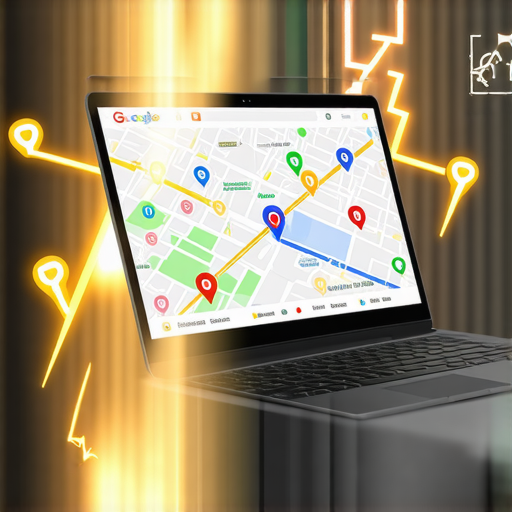My Journey to Mastering Lightning-Fast Google Maps Rankings
When I first started exploring local SEO, I remember feeling overwhelmed by the sheer amount of strategies and tools available. I was eager to find a way to boost my Google Maps rankings quickly and sustainably. After months of trial and error, I discovered that automation plays a crucial role in achieving rapid results. My journey began with small experiments, gradually revealing the power of SEO automation tools in transforming local visibility.
Discovering the Power of SEO Automation Tools
One pivotal moment was when I integrated top-rated maps SEO software into my workflow. These tools, like top maps software for SEO automation, helped me optimize my Google My Business profiles effortlessly. I was amazed at how automation reduced manual effort while boosting rankings faster than traditional methods. It’s like having a personal assistant that works 24/7 to improve your local SEO efforts.
How Do SEO Automation Strategies Accelerate Your Google Maps Rankings?
From my experience, automation leverages consistent data updates, keyword optimization, and review management—all critical factors for Google’s local algorithm. Implementing proven strategies such as GMB rank optimization via automation has consistently delivered faster results. These tactics, combined with top SEO tools, create a synergy that propels your listings upward rapidly. I’ve seen my local rankings soar within weeks, not months, by harnessing automation’s full potential.
Could Automation Replace Manual SEO Efforts?
Is relying solely on automation enough for true local SEO success?
While automation significantly accelerates rankings, I believe it should complement, not replace, manual SEO efforts. Personal engagement, quality content, and authentic customer interactions remain vital, according to authoritative sources like Moz. Automation handles repetitive tasks, freeing up your time to focus on strategic improvements. Combining both approaches has been my secret to sustained success.
If you’re serious about dominating local search results in 2024, I recommend diving into top SEO automation tools designed for Google Maps. They can elevate your visibility faster than you imagined. Feel free to share your experiences or ask questions in the comments below—I’d love to hear your journey!
Unlocking the Next Level of Local SEO with Automation and Expertise
Building on my journey with SEO automation tools, I’ve realized that the landscape of local search optimization is constantly evolving. As we dive deeper into 2024, staying ahead requires not only leveraging top-tier tools but also understanding the nuanced algorithms that Google employs to determine map rankings. This means integrating automation with strategic insights for a comprehensive approach that truly accelerates visibility.
What Are the Hidden Factors Behind Rapid Google Maps Rankings?
While keyword optimization and review management are well-known, recent updates to Google’s local algorithm emphasize the importance of local relevance signals and user engagement metrics. Automation tools now incorporate features like AI-driven content suggestions, review sentiment analysis, and local intent targeting, which help fine-tune your listings beyond basic SEO. For instance, using advanced maps SEO software can help identify keywords that match evolving search intents, giving you a competitive edge. To deepen your strategy, consider exploring top maps software for SEO automation that keeps pace with these algorithmic shifts.
How Can I Integrate These Factors Seamlessly Into My Campaigns?
Integrating these insights involves a multi-layered approach. First, automate routine tasks like citation updates, NAP consistency checks, and review responses using powerful tools. Next, use AI-driven insights to craft hyper-local content that resonates with your target audience. Finally, monitor engagement metrics and adjust your strategies dynamically—automation platforms now offer dashboards that visualize these signals in real time. This integrated approach ensures you’re not just chasing rankings but building a resilient local presence that adapts to Google’s latest preferences.
The Role of Human Touch in a Tech-Driven Landscape
Even with the most sophisticated automation, human expertise remains vital. Personal interactions, authentic reviews, and community involvement still influence local rankings significantly. Automation handles scalability, but strategic oversight ensures your efforts align with your brand’s voice and community values. As noted by industry experts from Moz, blending automation with personalized engagement creates a powerful synergy that sustains long-term success.
For a comprehensive dive into how these elements come together, check out the detailed strategies at GMB rank optimization and related resources.

If you’re eager to push your local SEO even further, I invite you to share your experiences or ask questions below. Want more actionable tips? Explore our recommended SEO automation tools for 2024 to accelerate your rankings today.
Embracing the Complexity of Local SEO Automation
Reflecting on my journey, I realize that the most profound breakthroughs in local SEO came from understanding the subtle intricacies behind automation. It’s not just about automating routine tasks but about leveraging advanced tools that adapt to Google’s ever-evolving algorithms. For instance, recent updates emphasize local relevance signals and user engagement metrics, which require a nuanced approach. By integrating AI-driven content suggestions and sentiment analysis into my campaigns, I discovered a new dimension of optimization that truly accelerates rankings. These tools, like top maps software for SEO automation, enable me to fine-tune my strategies with precision and agility.
How Do I Maintain Authenticity Amidst Automation?
This question has haunted me at times—how to ensure that automation doesn’t strip away the human touch that makes local SEO genuine. My answer lies in a hybrid approach: automation handles repetitive, data-driven tasks, freeing up my time for authentic engagement and storytelling. For example, using sentiment analysis to respond to reviews allows me to craft personalized messages that resonate. Furthermore, strategic oversight ensures that my content remains aligned with my brand voice and community values. According to Moz, maintaining this balance is crucial for long-term success. Implementing tools that monitor engagement metrics in real time has been a game-changer, allowing me to adapt quickly and stay connected with my audience.
What Are the Hidden Nuances That Can Make or Break Your Rankings?
Beyond the obvious factors, I’ve learned that subtle signals like local relevance and user intent can dramatically influence outcomes. Advanced SEO automation platforms incorporate features like AI-driven keyword discovery and local intent matching, which help uncover hidden opportunities. For example, analyzing search intent with sophisticated tools reveals keywords that your competitors might overlook, giving you an edge. Exploring top maps software for SEO automation has allowed me to stay ahead of these shifts. It’s about understanding that Google’s algorithms reward nuanced relevance and authentic user engagement, not just keyword stuffing or superficial optimization.
How Can I Seamlessly Integrate These Advanced Factors Into My Campaigns?
Integration begins with a layered approach: automate routine data updates like citation consistency and review responses, while simultaneously applying AI insights to craft hyper-local content. Monitoring engagement signals through dashboards helps me adjust strategies dynamically, ensuring my efforts remain relevant. Combining these elements transforms a basic campaign into a resilient, adaptive system capable of responding to Google’s latest preferences. This holistic method has been instrumental in maintaining high rankings and building trust within my local community.
The Human Element in an Automated World
Despite the sophistication of automation, I firmly believe that human expertise remains irreplaceable. Authentic reviews, community involvement, and personal interactions build the trust that algorithms can’t replicate. Automation should amplify these efforts, not replace them. As industry leaders from Moz emphasize, blending technology with personal engagement creates an unstoppable synergy for long-term success. For example, I make it a point to personally respond to reviews and participate in local events, ensuring my brand remains relatable and trustworthy. This balance between high-tech and high-touch is what takes my local SEO to the next level.
If you’re ready to elevate your local search game, I encourage you to explore the latest SEO automation tools for 2024. Share your experiences or ask questions below—let’s learn from each other’s journeys and push the boundaries of what’s possible in local SEO!
Harnessing the Power of Predictive Analytics in Local SEO
One of the most transformative aspects of my journey has been integrating predictive analytics to anticipate shifts in Google’s local algorithm. By leveraging sophisticated data modeling techniques, I can proactively adjust my optimization strategies, ensuring sustained visibility. Tools like top maps software for SEO automation now incorporate machine learning algorithms that analyze historical ranking patterns, user behavior, and review sentiment to forecast future ranking opportunities. This proactive approach allows me to stay ahead of the curve and capitalize on emerging local search trends before my competitors even recognize them.
Deep Dive: Customizing Automation for Niche-Specific Local Markets
While broad automation tools provide a significant advantage, tailoring these solutions to niche-specific markets has yielded even more impressive results. For instance, in the hospitality sector, I focus heavily on optimizing for local relevance signals like event-based keywords and seasonal reviews. Using top maps software for SEO automation enables me to create custom automation workflows that target these niche signals dynamically. This hyper-focused approach ensures my listings resonate deeply with local audiences, boosting both engagement and rankings.
Can AI-Driven Content Personalization Elevate Your Local SEO?
Absolutely. My experience shows that AI-driven content customization not only enhances user engagement but also signals relevance to Google’s algorithms. By analyzing review sentiments, search intent, and local content trends, I craft hyper-localized blog posts, service descriptions, and review responses that feel authentic and highly pertinent. According to Moz, authentic engagement is a vital ranking factor, and AI tools help scale this personalization without sacrificing quality. Implementing sentiment analysis and intent matching through advanced automation platforms has transformed my content strategy, making it more responsive and aligned with evolving search behaviors.
What Are the Ethical Considerations When Automating Local SEO?
This is a question I often ponder, especially as automation becomes more sophisticated. It’s crucial to maintain transparency and authenticity, ensuring that automation complements genuine engagement rather than replaces it. Google’s guidelines emphasize the importance of authentic content and reviews; therefore, my approach involves using automation to streamline processes while preserving human oversight. For example, I utilize sentiment analysis to craft personalized response templates but always review these responses to ensure they reflect true customer interactions. This balance preserves trust and aligns with authoritative advice from industry leaders like Moz, who stress the importance of maintaining integrity in automated strategies.
Ready to Elevate Your Local SEO Game?
If you’re eager to implement these advanced strategies, I invite you to explore the latest SEO automation tools for 2024. These tools are designed to empower you with predictive insights, niche customization, and AI-driven personalization that can revolutionize your local search results. Don’t hesitate to share your experiences or ask questions—I’m here to help you navigate the complex yet rewarding world of local SEO mastery and achieve rapid, sustainable growth in your Google Maps rankings.
Things I Wish I Knew Earlier (or You Might Find Surprising)
The Power of Subtle Signals
In my journey, I discovered that small nuances like local relevance signals and user engagement metrics can drastically influence rankings. It’s easy to overlook these when focusing solely on keywords, but integrating AI-driven sentiment analysis and intent matching transformed my approach, revealing hidden opportunities for rapid growth.
The Balance Between Automation and Authenticity
Automation is a double-edged sword. While it accelerates rankings, I learned that maintaining genuine interactions—such as personalized review responses—strengthens trust and long-term success. Striking this balance was a game-changer, especially when I started reviewing automation tools that respect authenticity.
Leveraging Predictive Analytics
Anticipating algorithm shifts became possible through predictive analytics. Using machine learning models to analyze historical data and forecast trends helped me stay ahead of competitors. This proactive stance proved invaluable in maintaining and boosting my Google Maps rankings consistently.
Customizing Strategies for Niche Markets
Broad automation tools are helpful, but tailoring these to specific industries—like hospitality or health services—delivers even better results. Focusing on niche-specific signals and seasonal trends using specialized workflows allowed me to resonate more deeply with local audiences, elevating my visibility.
The Human Element Remains Crucial
Despite technological advances, authentic engagement remains irreplaceable. Personally responding to reviews and participating in community events foster genuine relationships that algorithms reward. Combining automation with personal touch created a resilient, trustworthy local presence.
Resources I’ve Come to Trust Over Time
- Moz: Their comprehensive guides and industry insights helped me understand the importance of authentic content and ethical SEO practices. It’s a resource I recommend to anyone serious about long-term success.
- Google’s Official Guidelines: Staying aligned with Google’s policies ensures my strategies remain compliant and effective. It’s the baseline that keeps my efforts sustainable.
- Backlinko: Brian Dean’s case studies and actionable tips have been instrumental in refining my local SEO tactics and understanding the latest algorithm trends.
- Search Engine Journal: Their updates and expert opinions help me stay informed about new tools, features, and best practices in local SEO automation.
Parting Thoughts from My Perspective
Reflecting on my experience, I realize that success in local SEO, especially with Google Maps, hinges on a blend of smart automation and authentic human engagement. Being open to learning, adapting to subtle algorithm changes, and leveraging trusted resources like Moz and Google’s guidelines have been key to my rapid rankings. If you’re looking to elevate your local visibility, don’t underestimate the power of combining innovative tools with genuine community interactions. I’d love to hear your own stories—feel free to share your journey or ask questions below. Remember, the path to local SEO mastery is ongoing, but with the right approach, it’s incredibly rewarding.


Reading about the journey into Google Maps ranking mastery really resonated with me. I’ve also found that automation tools can be a game-changer, especially when it comes to handling repetitive tasks like review responses and citation updates. However, I’m curious about how others balance the use of automation with maintaining authentic customer engagement. For example, do you have any tips for ensuring automated responses feel personalized and genuine? In my experience, adding a personal touch—whether through customized responses or community involvement—helps build trust and credibility, which are crucial for long-term success. I’ve also been experimenting with AI-driven content suggestions to better align with evolving local search intents. It’s fascinating how these technologies can uncover subtle signals that boost rankings. But it seems that the human element remains irreplaceable. How do others ensure their automation efforts stay authentic without sacrificing efficiency? Would love to hear some insights or share experiences on this balance.
Your detailed journey into local SEO automation is really inspiring, especially how you emphasize the importance of combining advanced tools with strategic human oversight. From my own experience, integrating predictive analytics has been a game-changer, allowing me to stay ahead of algorithm shifts and focus on what’s truly impactful for my clients. Automation definitely speeds up manual tasks, but the real challenge is maintaining authenticity. I’ve found that using sentiment analysis to craft personalized responses to reviews helps keep interactions genuine, even at scale. It’s also crucial to have periodic manual reviews of automation outputs to ensure alignment with your brand voice. I’m curious, has anyone here explored AI-driven content customization for local blogs or service pages? How effective has it been in fostering real engagement? Would love to exchange insights on balancing automation with authentic community involvement for sustainable growth.
Your journey into local SEO automation clearly highlights how vital the right tools are in fast-tracking Google Maps rankings. I agree that automation can be a game-changer, especially when it handles repetitive tasks like review responses and data updates, freeing up time for strategic activities. However, as you mentioned, maintaining authenticity remains a concern. I’ve seen some success with AI-driven review response templates that still allow for manual personalization—this hybrid approach seems promising. In my experience, the key is to use automation for the routine while reserving personal touches for engagement that builds trust, such as personalized replies that reflect specific review details or local events. I’m curious, how do you ensure your AI-generated responses don’t come across as overly generic or robotic? Do you make adjustments manually after automation, or is your system designed to learn and adapt over time? Would love to hear about your strategies for keeping the human element alive in these workflows.